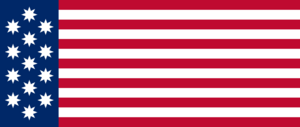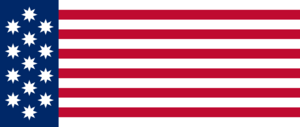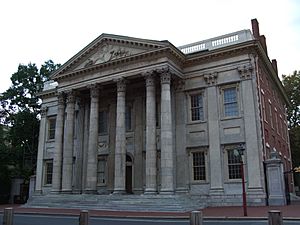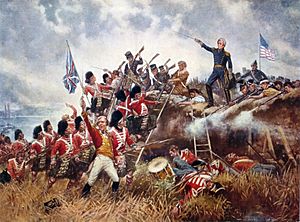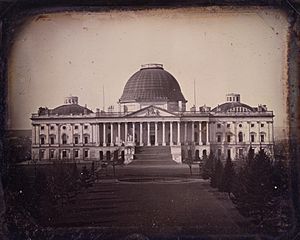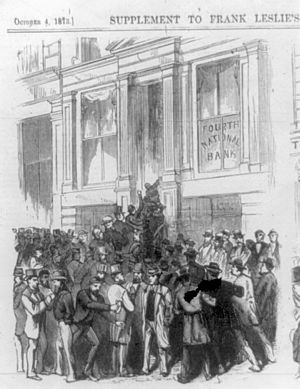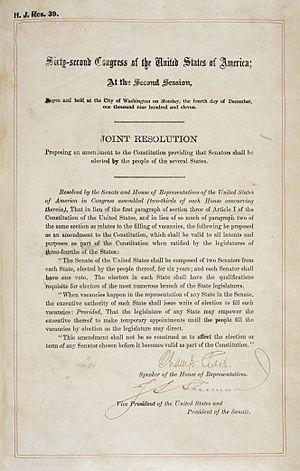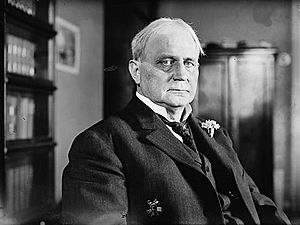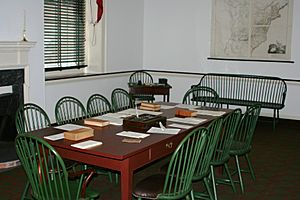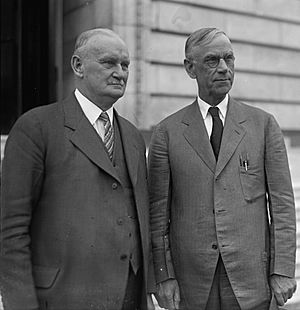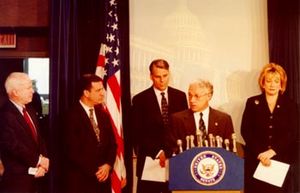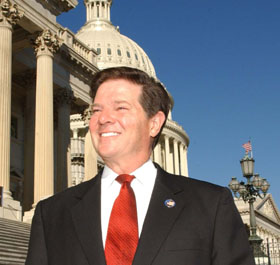History of the United States Congress facts for kids
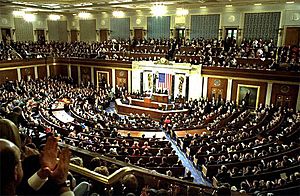
The history of the United States Congress tells the story of the United States Congress from 1789 until today. It also looks at earlier groups like the Continental Congress (1774-1781) and the Congress of the Confederation (1781-1789).
The U.S. Congress started in 1789. It's a two-part legislative body, meaning it makes laws. It was created by the U.S. Constitution in 1788. Congress has two parts: the Senate and the House of Representatives. The Senate has two members from each state. The House has members based on each state's population. This two-part system was inspired by the legislatures in the original thirteen colonies. These, in turn, were like the English Parliament.
The way Congress works has always been shaped by political parties. From the very beginning, Americans have mostly had a two-party system. People joined parties based on their ideas, money issues, where they lived (city or country), religion, or popular movements.
Over time, Congress's power changed. Sometimes it was very powerful, especially in the 1800s. In the 1900s, the President often became more dominant, especially during wars. Sometimes Congress was full of disagreements between parties. Other times, members worked together.
Experts often divide Congress's history into four main periods:
- The formative era (1780s–1820s)
- The partisan era (1830s–early 1900s)
- The committee era (1910s–1960s)
- The contemporary era (1970s–today)
Contents
The Story of the U.S. Congress
Early Beginnings: The Continental Congress
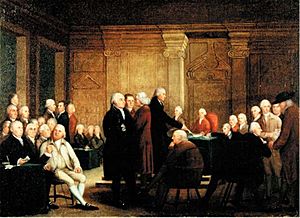
The story of the U.S. Congress really begins with the First Continental Congress in 1774. A more important meeting happened on May 10, 1775, with twelve colonies present. A year later, on July 4, 1776, this group declared the thirteen colonies free. They called themselves the "United States of America."
The Second Continental Congress acted as the national government until 1781. It managed the war and foreign relations. It also created the Articles of Confederation, which became the first U.S. Constitution. People who supported this new government were often called "Congress Men." The Congress of the Confederation then governed the U.S. for eight years (1781-1789). During this time, there was no president. Congress was in charge.
The Articles of Confederation: A Weak Government
The Articles of Confederation were written in 1776 and started in 1781. This plan created a weak central government. It had only one house, where each state had an equal vote. Each state could also block most actions. There was no president or national court system.
This Congress had limited power. It could handle foreign affairs and military matters. But it could not collect taxes or control trade between states. It also couldn't make sure laws were followed. This system caused problems. States fought over money, and the government struggled to stop rebellions or protect the country.
Annapolis, Maryland, became the temporary capital after the Treaty of Paris in 1783. Congress met there from November 1783 to June 1784. It was in Annapolis that George Washington famously resigned as commander of the Continental Army.
For the 1783 Congress, a local craftsman named John Shaw made an American flag. It was a bit different from other flags of the time. The blue part with stars went all the way down the flag. Shaw made two versions: one starting with a red stripe, and one with a white stripe.
In 1787, a meeting was called in Annapolis to discuss trade. But only five states sent delegates. This meeting, called the "Annapolis Convention," decided to call another meeting. This new meeting would be in Philadelphia the next year. Its goal was to fix the Articles of Confederation. Instead, the Philadelphia meeting wrote a brand new document: the Constitution of the United States.
Creating the U.S. Congress
In May 1787, a special meeting, called the Constitutional Convention, took place in Philadelphia. The goal was to solve the problems with the Articles of Confederation. But instead, they decided to create a completely new system. All states except Rhode Island sent representatives.
One of the biggest arguments was about how Congress should be set up. Many states already had "two-house" legislatures. Edmund Randolph's Virginia Plan suggested a two-house Congress. The lower house would be elected by the people. The upper house would be chosen by the lower house. This plan favored larger states because representation was based on population.
Smaller states liked the New Jersey Plan. This plan suggested a one-house Congress where all states had equal votes. People called Federalists and Anti-Federalists argued about how much power Congress should have. These arguments continued even after the Constitution was approved.
The Constitution gave more power to the national government. This included controlling trade between states, managing foreign affairs, and creating a national currency. These powers were seen as important to make the new country successful. But states still kept control over many other things.
Finally, a "compromise" was reached. It's known as the Connecticut Compromise or the Great Compromise. It created two houses:
- One house would have representation based on population (the House of Representatives).
- The other house would have equal representation for each state (the Senate).
To keep states powerful, state legislatures, not the people, would elect senators.
To prevent any one part of the government from becoming too strong, the Constitution created a separation of powers. This divided responsibilities among the executive (President), legislative (Congress), and judicial (courts) branches. The Constitution was approved by the end of 1788. It officially began on March 4, 1789.
The Constitution says each state gets two senators. The size of the House of Representatives depends on the number of states and their populations. The number of House members is set by law, not the Constitution. The House grew as new states joined and the population increased. In 1911, a law set the House at 435 members. Since then, the U.S. population has grown a lot. So, each member of Congress now represents many more people than before. There are also a few non-voting members who represent U.S. territories.
The 1790s: Early Political Battles
The Constitution was a big topic for Americans until the 1792 elections. There was a fight between the Federalist Party (who supported the Constitution) and the Anti-Federalist Party (who opposed it). After the first elections in 1789, Federalists controlled Congress.
From 1792 to 1800, the main struggle was between Alexander Hamilton's Federalist Party and Thomas Jefferson's Democratic-Republican Party. Jefferson's party gained control of the House of Representatives after the 1792 elections. This happened partly because James Madison, a top Federalist, joined with Jefferson. Madison opposed Hamilton's idea for a national bank.
In 1794, the Democratic-Republicans lost control of the Senate. This was partly because they opposed Jay's Treaty, which was unpopular. In 1796, they also lost the House. This was due to their support for the unpopular French Revolution. However, Jefferson still became Vice President. George Washington was re-elected President in 1792 with wide support. John Adams, a Federalist, became Vice President in 1796.
Early 1800s: Clashes and Compromises
The early 1800s saw many disagreements between the House and Senate. After winning the 1800 elections, Jefferson's Democratic-Republican Party controlled both houses of Congress and the presidency. This was because the idea of states' rights became popular.
Federalists, though they lost the presidency and Congress, still had power in the Supreme Court. Chief Justice John Marshall led the Court. One justice, Samuel Chase, was very partisan. He openly criticized President Jefferson. Jefferson asked Congress to impeach Chase. The House started the impeachment in 1804. The Senate tried him but found him not guilty. This decision helped protect the independence of the courts. From then on, Supreme Court members generally avoided open attacks on Congress or the President. Chase was the only Supreme Court justice ever impeached by Congress.
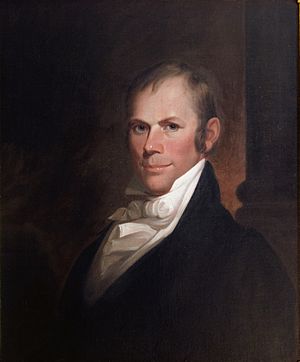
Henry Clay of Kentucky was a powerful Speaker of the House in the 1810s. In the Senate, there was a careful balance between free states in the North and slave states in the South. The number of free and slave states was kept equal through compromises, like the Missouri Compromise of 1820. This balance broke down in 1850 when California joined as a free state. The Compromise of 1850 delayed a major conflict. Meanwhile, the North grew faster and had more power in the House.
The Partisan Era (1830s–1900s)
The Rise of New Parties
In 1824, John Quincy Adams won the presidency. Andrew Jackson claimed a "corrupt bargain" had cheated him. Jackson had won more votes, but not a majority in the electoral college. Henry Clay, who opposed Jackson, gave his votes in the House to Adams.
Jackson and his followers easily won the 1826 Congressional Election. They took control of Congress. As the Second Party System formed, the Whigs and Jackson's supporters (called "Democrats" by 1834) fought for control.
In the 1832 Senate elections, the National Republican party, which opposed Jackson, gained control. This happened after President Jackson disagreed with his Vice-President John Calhoun. This disagreement was about whether South Carolina could refuse to follow the Tariff of 1828. Calhoun's new Nullifier Party eventually joined with Henry Clay's National Republican Party. They formed the U.S. Whig Party in 1834.
The Whigs won power in 1840. President Martin Van Buren had become unpopular because he couldn't fix the economic problems from the Panic of 1837. After President William Henry Harrison died in 1841, John Tyler became president. Tyler soon disagreed with Clay and the Whigs in Congress. He kept blocking their bills for a national banking act. Because of this, Tyler's supporters helped the Democrats gain control of the House in the 1842 elections.
Democrats won Congress again in 1844, largely due to support for adding Texas to the U.S. But the Whigs took back both houses in 1846, partly because people opposed the Mexican-American War. Democrats regained control in 1848 after the U.S. won the Mexican–American War.
In 1854, Senator Stephen A. Douglas proposed the Kansas-Nebraska Act. This act caused strong opposition. This opposition led to the creation of the new Republican Party. The Know Nothing Party also formed around this time. The Democrats regained control of Congress. The Know Nothing Party and Republican Party worked together to elect Nathaniel P. Banks as Speaker of the House.
By the 35th United States Congress, Democrats controlled both houses again. The Know Nothing Party soon fell apart. In the North, its members joined the Republicans. Republicans took control of the House in the 1858 elections. This happened after the controversial Dred Scott court ruling in 1857. In 1860, Abraham Lincoln led the Republicans to victory. They now fully controlled Congress.
Civil War and Reconstruction
Congress played a huge role in the American Civil War. Republicans controlled both houses. After the war ended in 1865, President Andrew Johnson oversaw Reconstruction. But he disagreed with the Radical Republicans in Congress. After the 1866 elections, the Radicals gained power. They tried to remove President Johnson from office (but he was not convicted). They then controlled Reconstruction policy.
The Democrats gained power in the House after the 1874 election. This was partly due to the Long Depression that started with the Panic of 1873. Democrats continued to control the House and even gained the Senate in 1878 as the depression worsened.
The Gilded Age (1877–1901) mostly saw Republicans control Congress and the Presidency. Democrats still held power in the Southern states. State legislatures continued to elect senators. This meant powerful state politicians often fought to control the legislature to win a Senate seat.
Sometimes, Senate elections were unfair due to corruption. Other times, disagreements in state legislatures prevented a senator from being chosen for years. These problems were fixed by the Seventeenth Amendment (approved in 1913). This amendment allowed people to directly elect their senators.
In 1888, support for Republican tariff policies helped them regain the House. But Democrats took back the House in 1890. They also won the Presidency and Senate in 1892 as opposition to President Harrison's tariffs grew. Republicans regained Congress in 1894. This was after President Cleveland and the Democrats failed to fix the depression from the Panic of 1893. William McKinley became President in 1896. He helped the U.S. economy recover and started the Progressive Era.
The Committee Era (1910s–1960s)
The Progressive Era and Strong Leaders
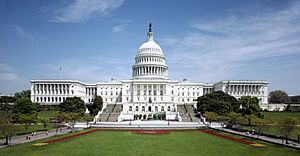
The Progressive Era (1896–1932) saw strong party leaders in both houses of Congress. In the House, the Speaker became very powerful under Thomas Brackett Reed and later Joseph Gurney Cannon. The Senate was largely controlled by a few powerful men.
In 1910, a revolt against Speaker Cannon, led by George W. Norris, made Congress members more independent of their party. It also strengthened the seniority system. Committee chairmen remained very powerful in both houses until the 1970s.
In 1901, President William McKinley was assassinated. His Vice President, Theodore Roosevelt, became president. Roosevelt changed the Republican Party's image to be more progressive. He was a very strong leader during his presidency (1901-1909). However, Roosevelt's successor, William Howard Taft, did not continue these progressive policies. This caused a big split between conservative (pro-Taft) and progressive (pro-Roosevelt) Republicans. In the 1910 elections, Democrats regained control of the House.
Important Changes to Congress
Two big changes happened to Congress around the early 1900s:
- Direct election of senators: Senators were no longer chosen by state governments. The Seventeenth Amendment made them directly elected by the people. Some people thought this was good because senators became more aware of public opinion. Others felt it weakened the power of state governments. This change made the Senate and House more similar in how they connected to voters.
- "Lame duck" reforms: The Twentieth Amendment was a positive change. It ended the power of "lame-duck" members of Congress. These were members who had lost elections or were retiring but stayed in office for a while. The amendment made sure that newly elected members took office sooner.
The split between conservative and progressive Republicans in the 1912 election helped Democrats win the Presidency and full control of Congress. Even when Republicans reunited in 1914, they couldn't regain Congress. This was due to President Wilson's popular "New Freedom" policies.
However, Wilson's failure to protect American neutrality before World War I helped Republicans gain House seats in 1916. But Wilson still won the presidency. Democratic Speaker Champ Clark kept his position. By the 1918 elections, many American men were fighting in World War I. Voters wanted the war to end. Republicans, strongly supported by Theodore Roosevelt, easily regained control of the Senate and Congress.
After the war, the Wilson administration faced many problems. These included opposition to joining the League of Nations, major strikes, and fears about communism. As a result, Republicans won a stronger majority in both houses of Congress in the 1920 election. Republican Warren Harding also won the presidency by a huge margin. However, Harding's administration struggled with the economy.
In 1923, Harding died, and Vice President Calvin Coolidge became president. Under Coolidge, the economy improved, and conservatives regained control of Congress in 1924. Republicans generally controlled Congress until 1931. This changed after many Republican House members died, and Democrats won their special elections. This happened as Republican President Herbert Hoover failed to fix the Great Depression.
The Great Depression and the New Deal
On October 29, 1929, known as Black Tuesday, the stock market crashed. The U.S. and much of the world entered a major economic downturn. President Herbert Hoover and the Republican Congress passed the Smoot–Hawley Tariff Act. Many believe this law made the economic situation much worse.
In the 1930 elections, Republicans barely kept control of the House and Senate. But soon after, special elections for vacant House seats gave Democrats a four-seat majority. In the 1932 Senate elections, Democrats easily won control of the Senate. This election also saw Franklin D. Roosevelt become President. Roosevelt could now start his historic New Deal policies with a Democrat-controlled Congress.
Roosevelt's election in 1932 marked a shift in power towards the presidency. Many New Deal ideas came from the White House and were sent to Congress for approval. During Roosevelt's long time as president (1933-1945), the Democratic Party controlled both houses of Congress. They had a huge majority, often two-thirds of Congress.
After the 1938 elections, Democrats still controlled Congress. But Republicans gained many seats in both the House and Senate. This made it harder for Democrats to expand New Deal programs. Even so, Democrats kept a strong majority. Republicans and conservative Democrats from the South formed a group called the Conservative Coalition. They worked together to limit the power of New Dealers in Congress.
In 1940, pro-Roosevelt Democrats from the North regained firm control of Congress. In 1942, after the U.S. entered World War II, voter turnout dropped. Democrats kept control of Congress, but Republicans gained many seats. Despite this, Democratic Speaker of the House Sam Rayburn and Senate majority leader Alben W. Barkley, both Roosevelt allies, kept their positions. By the 1944 elections, Roosevelt was seen as a wartime hero. He was elected to a fourth term, and pro-Roosevelt Democrats regained strong control of Congress.
Postwar Era: Shifting Power
Congress worked to become more efficient after the war. In 1945, members worked to reduce the number of committees and require lobbyists to register.
In the 1946 elections, Republicans regained control of both the Senate and House. This was partly because President Truman struggled with many labor strikes after the war. Democrats took back Congress in 1948. This was thanks to President Harry Truman's support from rural areas. He promised to repeal the Taft–Hartley Act. With this victory, liberal Democrats regained control.
In 1950, the Conservative Coalition, now led by Republican Senator Robert A. Taft, regained control of the Senate. This gave Southern Democrats control of many committees. In 1952, Republican Dwight D. Eisenhower, a decorated World War II general, was elected President by a landslide. He also helped Republicans gain control of both houses of Congress.
After the 1954 elections, the Democratic Party controlled both houses of Congress until 1994. Democrats regained control in 1954 due to high unemployment and dislike of Republican Senator Joseph McCarthy. While the Conservative Coalition still had many seats, liberal Democratic Congressman Sam Rayburn became Speaker again. Liberal Democratic Senator Lyndon Johnson became Senate Majority Leader.
Two years later, President Eisenhower won another huge victory in the 1956 election. He was popular for his actions in foreign policy and supporting civil rights. But Eisenhower couldn't give Republicans control of Congress again. In 1958, after a recession, the Conservative Coalition lost control of Congress. This election gave liberal Democrats enough votes to overcome a filibuster in the Senate. In 1960, John F. Kennedy won the presidency. The Democrats kept their majority. From 1961 to 1969, Democrats held the majority under Presidents Kennedy and Johnson.
In 1964, President Johnson's Great Society policies were successful. Democrats gained enough seats in Congress to have a two-thirds majority, meaning they could override a presidential veto. This weakened the Conservative Coalition. Republicans then agreed to be more moderate.
By 1968, Johnson's continuation of the Vietnam War was very unpopular. Republican Richard Nixon was elected President. Democrats lost their strong majority in the Senate. However, Democrats still kept a large majority in the House and Senate.
The Contemporary Era (1970s–Today)
Democrats continued to hold a good majority after the 1970 elections. In 1972, Richard Nixon won 49 states in the presidential election. He gained popularity by improving relations with China, signing arms treaties with the Soviet Union, and convincing the public the Vietnam War was ending. Despite this, Democrats still held a majority in Congress.
The Return of Strong Party Divisions
The next fifty years generally saw small majorities in Congress. Some believe this led to more intense party divisions. Lawmakers used to meet informally to discuss and compromise on national problems. But since the mid-1950s, members of Congress have voted more and more along party lines. They are less willing to compromise with the other side. Experts disagree on why this is happening and if it will continue.
Watergate and Its Impact
Nixon's political career was severely damaged by the Watergate scandal. On August 9, 1974, he became the first U.S. President to resign. By the 1974 elections, Gerald Ford's popularity was hurt after he pardoned Nixon and couldn't fix the ongoing economic problems.
Watergate changed how Congress worked with the other branches. It led to Congress overseeing federal intelligence agencies more closely. It also led to the War Powers Resolution, which limits the President's power to send troops into combat. Congress also reformed campaign finance laws and investigated wrongdoing in the executive branch.
After Watergate, Congress started to take back its power to oversee the President and create laws. Democrats regained a two-thirds majority in Congress and enough votes to overcome a filibuster in the Senate. In 1978, Republicans gained many seats in Congress. This was due to high inflation across the country. In 1980, Republicans won both the Senate majority and the Presidency. Ronald Reagan became President.
The Growth of Lobbying
History of lobbying in the United States The 1971 Federal Election Campaign Act set up the Federal Election Commission. It limited how much money individuals, parties, and political action committees (PACs) could give to candidates. But there were loopholes. These loopholes led to a rapid increase in PACs and "soft money" contributions. Soft money could fund general political causes, not tied to specific candidates.
Later, the 2002 McCain-Feingold campaign finance law limited some campaign donations. But it didn't limit "soft money" from corporations, unions, and wealthy people. Some believe that laws meant to reduce the influence of rich donors actually made PACs more powerful. From 1974 to 1984, the number of PACs grew from 608 to 3,803. Their donations jumped from $12.5 million to $120 million.
There are concerns that PACs have too much influence over Congress. In 2009, there were 4,600 business, labor, and special-interest PACs. Both Republicans and Democrats receive money from PACs. Critics say PACs allow special interests to have too much power. Supporters say PACs don't represent only small groups. Efforts to reduce PAC influence have generally failed. This is because changes might help one political party more than the other. Some believe this money weakens political parties. Candidates can get money directly from PACs instead of from their party.
Lobbying groups, sometimes called "K Street Lobbyists," have even been reported to write parts of bills that later became law. These groups have also become good at hiding their true identity. They form coalitions with innocent-sounding names.
The 21st Century and Party Divisions
In the early 2000s, Congress was marked by strong party divisions. Many votes were split exactly along party lines. Some wonder if this intense political fighting has stopped lawmakers from dealing with big issues like global warming and deficit spending. It might also prevent them from finding bipartisan compromises. In 2009, two former U.S. Secretaries of State said America was "full of partisan bickering" while facing serious threats.
Congress itself has tried to reduce party divisions. Intense party divisions combined with ethics investigations can be powerful. For example, Representative Tom DeLay left the House partly due to his dealings with a lobbyist. DeLay later complained about what he called the "criminalization of politics." He felt that opponents tried to ruin people's lives. However, a judge later said that the rule of law was more important than political parties. Congress can still pass bills even with strong party opposition, like the recent health care law.
Congress Today
The 117th Congress (2021-2022) saw Democrats keep control of the House. The Senate was evenly split between Republicans and Democrats (including independents who vote with Democrats). Democrats effectively gained control of the Senate because the Vice President, Kamala Harris, can cast tie-breaking votes. With Democrats controlling the Presidency, Senate, and House, the Democratic Party gained significant political power after the 2020 election.
In response to the COVID-19 pandemic, this Congress passed the American Rescue Plan in March 2021. This plan provided about $1.9 trillion for economic recovery programs. After the 2021 United States Capitol attack on January 6, 2021, Congress also passed the Capitol Police Emergency Assistance Act of 2021. This law gave more support to the United States Capitol Police. In December 2021, the Uyghur Forced Labor Prevention Act was passed. This bill addresses issues related to forced labor in China's Xinjiang province.
In late 2021 and early 2022, inflation reached a 40-year high. Disapproval of President Biden grew. Many expected Republicans to win control of both houses in the 2022 elections. After the 2022 Russian invasion of Ukraine, Congress proposed laws to send money and aid to Ukraine. The Defending Ukraine Sovereignty Act of 2022 aims to counter Russian actions and speed up security help for Ukraine.


